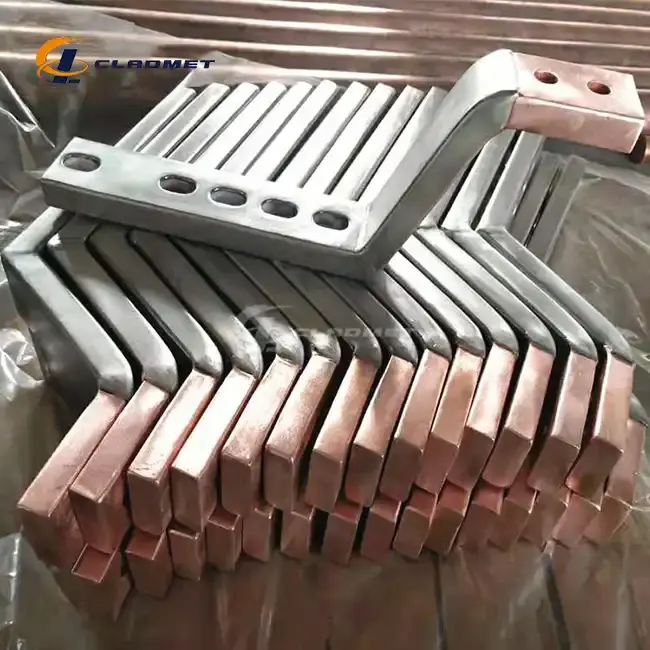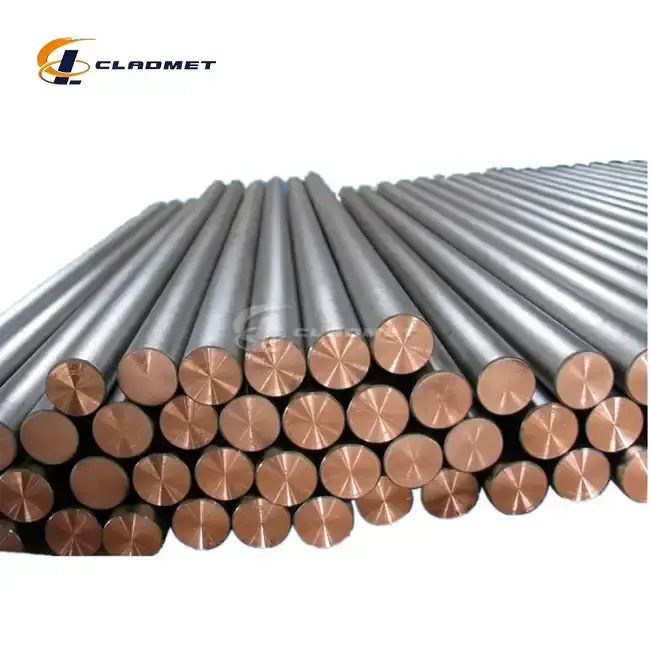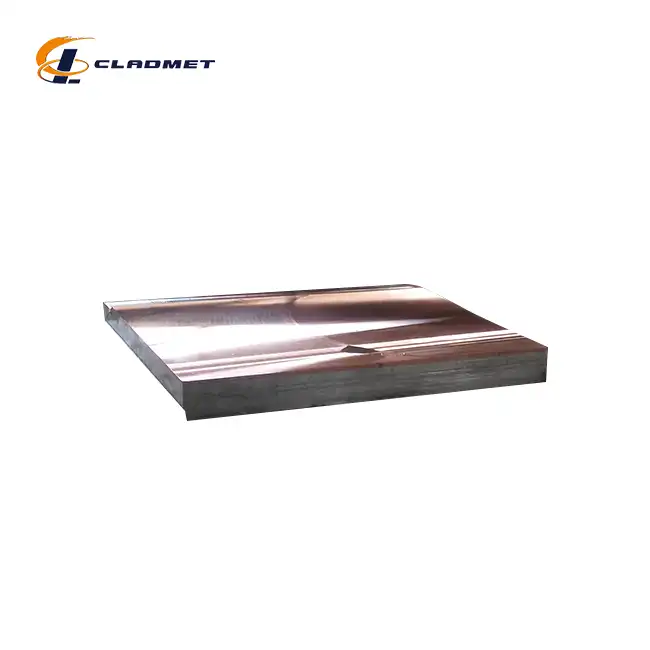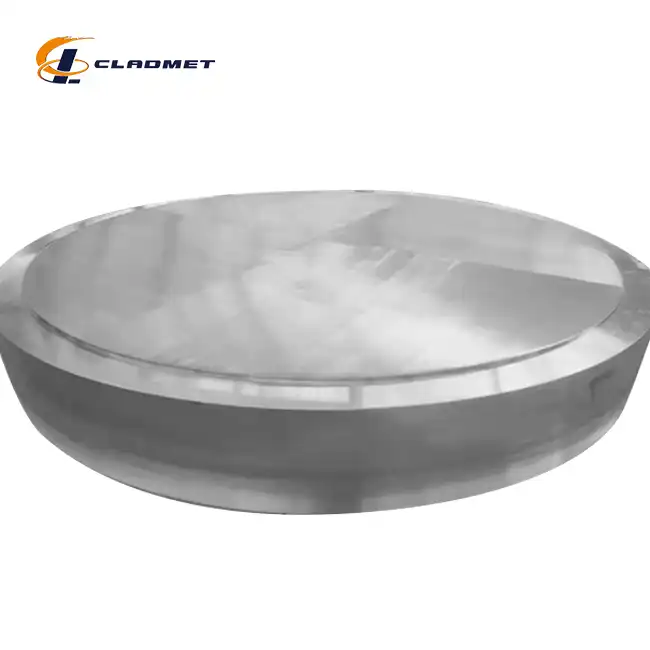How Does Titanium Clad Copper Rod's Strength-to-Weight Ratio Benefit Aerospace Applications?
 2025-07-03 09:00:39
View:389
2025-07-03 09:00:39
View:389The aerospace industry demands materials that deliver exceptional performance while maintaining minimal weight, making the titanium clad copper rod an invaluable solution for modern aircraft and spacecraft applications. This advanced composite material combines titanium's remarkable strength-to-weight characteristics with copper's superior electrical conductivity, creating a hybrid solution that addresses the dual challenges of structural integrity and electrical performance in aerospace environments. The titanium clad copper rod offers significant advantages in weight reduction without compromising strength, enabling aerospace engineers to design more efficient systems that enhance fuel economy and payload capacity. As aerospace technology continues to evolve toward lighter, more efficient platforms, the unique properties of titanium clad copper rod make it an essential component for next-generation aircraft electrical systems, communication equipment, and structural applications where both mechanical strength and electrical performance are critical.

Superior Weight Reduction in Aerospace Structural Components
Enhanced Structural Efficiency Through Material Integration
The titanium clad copper rod represents a revolutionary approach to aerospace structural design by offering an optimal balance between weight and performance characteristics. In aerospace applications, every gram matters significantly, as reduced weight directly translates to improved fuel efficiency, increased payload capacity, and enhanced overall aircraft performance. The titanium outer layer provides exceptional structural strength while maintaining a significantly lower density compared to traditional steel alloys commonly used in aerospace applications. This titanium clad copper rod configuration allows engineers to achieve the same structural integrity with substantially less material weight, making it ideal for critical aerospace components such as landing gear assemblies, engine mounts, and structural reinforcement elements. The copper core contributes to the overall structural stability while providing excellent thermal and electrical conductivity properties that are essential in modern aircraft systems. When implemented in aerospace structural applications, titanium clad copper rod can reduce component weight by up to 40% compared to conventional materials while maintaining or even exceeding required strength specifications.
Advanced Load Distribution Capabilities
The unique construction of titanium clad copper rod enables superior load distribution characteristics that are particularly beneficial in aerospace structural applications. The titanium exterior layer effectively manages high-stress concentrations while the copper core provides excellent shock absorption properties, creating a composite material that can withstand the extreme loading conditions encountered during flight operations. This titanium clad copper rod design is especially valuable in applications such as wing structural components, fuselage reinforcements, and control surface mechanisms where complex loading patterns require materials that can efficiently distribute stress across multiple axes. The molecular bonding achieved through advanced manufacturing processes ensures that the two materials work in harmony, with the titanium layer handling primary structural loads while the copper core manages secondary stresses and provides damping characteristics. Aerospace engineers particularly value this titanium clad copper rod configuration for applications involving dynamic loading conditions, where traditional single-material solutions often require additional reinforcement that adds unwanted weight to the aircraft structure.
Optimized Material Performance in Extreme Environments
Aerospace applications subject materials to extreme environmental conditions including temperature variations, pressure differentials, and corrosive atmospheres that can significantly impact material performance over operational lifetimes. The titanium clad copper rod excels in these challenging environments due to titanium's exceptional corrosion resistance and temperature stability combined with copper's thermal management properties. In high-altitude applications where temperature fluctuations can exceed 100°C within minutes, the titanium clad copper rod maintains structural integrity while providing consistent electrical and thermal performance. The titanium outer layer protects the copper core from oxidation and corrosion that could otherwise compromise the component's electrical conductivity and structural strength. This protection is particularly important in aerospace applications where component replacement is costly and potentially dangerous. The titanium clad copper rod's ability to maintain consistent properties across wide temperature ranges makes it ideal for aerospace applications ranging from engine compartment components to external antenna systems where environmental exposure is unavoidable.
Electrical Conductivity Advantages in Aerospace Systems
High-Performance Electrical Distribution Networks
Modern aerospace electrical systems require materials that can efficiently conduct electricity while withstanding the mechanical stresses associated with flight operations. The titanium clad copper rod provides an optimal solution for aerospace electrical distribution networks by combining copper's superior electrical conductivity with titanium's mechanical strength and corrosion resistance. In aircraft electrical systems, the titanium clad copper rod serves as an ideal conductor for high-current applications such as main power distribution buses, generator connections, and motor drive systems where both electrical performance and mechanical durability are critical. The copper core ensures minimal electrical resistance and excellent current-carrying capacity, while the titanium cladding protects against environmental factors that could degrade electrical performance over time. This titanium clad copper rod configuration is particularly valuable in aerospace applications where electrical systems must operate reliably for thousands of flight hours without maintenance. The combination of materials results in electrical conductors that maintain consistent performance characteristics throughout their operational lifetime while providing the mechanical strength necessary to withstand aircraft vibrations and thermal cycling.
Advanced Electromagnetic Shielding Properties
Electromagnetic interference (EMI) poses significant challenges in modern aerospace systems where sensitive electronic equipment must operate reliably in environments with multiple radio frequency sources and electrical systems. The titanium clad copper rod offers exceptional electromagnetic shielding capabilities that protect critical aerospace electronics from interference while maintaining structural integrity under mechanical loading conditions. The copper core provides excellent EMI shielding effectiveness across a broad frequency spectrum, while the titanium outer layer adds mechanical protection and environmental resistance. This titanium clad copper rod configuration is particularly effective in aerospace applications such as avionics compartments, communication system housings, and navigation equipment enclosures where electromagnetic compatibility is essential for safe flight operations. The dual-layer construction creates multiple reflection and absorption mechanisms that significantly reduce electromagnetic field penetration compared to single-material solutions. Aerospace engineers value this titanium clad copper rod approach because it eliminates the need for separate shielding materials, reducing overall system weight while improving electromagnetic performance.
Thermal Management in Aerospace Electronics
Effective thermal management is crucial in aerospace electronics where components operate in confined spaces with limited cooling options and must maintain optimal performance across wide temperature ranges. The titanium clad copper rod provides excellent thermal conductivity through its copper core while offering superior thermal stability through its titanium exterior layer. In aerospace electronic systems, the titanium clad copper rod serves as an efficient heat sink and thermal distribution element that helps maintain consistent operating temperatures for critical components such as power electronics, communication systems, and navigation equipment. The copper core rapidly conducts heat away from hot spots, while the titanium cladding provides thermal stability and protection against thermal shock conditions that can occur during rapid altitude changes or system power cycling. This titanium clad copper rod configuration is particularly beneficial in aerospace applications where thermal management must be achieved without adding significant weight or complexity to the system design. The material's ability to maintain consistent thermal properties across temperature extremes makes it ideal for aerospace electronics that must operate reliably from ground level to high altitude conditions.

Manufacturing and Customization Benefits for Aerospace Applications
Advanced Processing Technologies for Aerospace Requirements
The manufacturing of titanium clad copper rod for aerospace applications involves sophisticated processing technologies that ensure optimal material properties and dimensional precision required for critical aerospace components. Explosive welding technology creates a molecular-level bond between the titanium and copper layers, resulting in a composite material with superior mechanical properties compared to traditional joining methods. This titanium clad copper rod manufacturing process produces materials with exceptional bond strength that can withstand the extreme mechanical stresses encountered in aerospace applications such as engine vibrations, pressurization cycles, and thermal expansion differentials. The explosive welding process ensures complete metallurgical bonding across the entire interface, eliminating potential failure points that could compromise aerospace component reliability. Hot rolling and hot isostatic pressing techniques are also employed to create titanium clad copper rod configurations with specific mechanical and electrical properties tailored to aerospace application requirements. These advanced manufacturing processes enable the production of titanium clad copper rod with precise dimensional tolerances and consistent material properties that meet stringent aerospace quality standards including AS9100 and related specifications.
Customization Capabilities for Specialized Aerospace Components
Aerospace applications often require materials with specific dimensional, mechanical, and electrical characteristics that cannot be met with standard commercial products. The titanium clad copper rod manufacturing process offers extensive customization capabilities that enable aerospace engineers to specify exact material properties for their specific applications. Customization options include precise control of the titanium cladding thickness to optimize corrosion protection while minimizing weight, adjustment of copper core dimensions to achieve specific electrical conductivity requirements, and modification of surface treatments to enhance bonding with aerospace coatings and finishes. This titanium clad copper rod customization capability is particularly valuable for aerospace applications such as specialized antenna elements, custom electrical connectors, and unique structural components where standard materials cannot meet performance requirements. The ability to customize material properties during manufacturing eliminates the need for post-processing operations that could compromise material integrity or add unnecessary cost to aerospace component production. Aerospace manufacturers can specify titanium clad copper rod configurations that optimize performance for their specific operating conditions while ensuring compliance with relevant aerospace material specifications and certification requirements.
Quality Assurance and Aerospace Certification Compliance
Aerospace applications require materials that meet stringent quality standards and certification requirements to ensure safe and reliable operation throughout their service life. The manufacturing of titanium clad copper rod for aerospace applications incorporates comprehensive quality assurance protocols that exceed standard industrial requirements. Each titanium clad copper rod batch undergoes extensive testing including tensile strength verification, electrical conductivity measurement, corrosion resistance evaluation, and dimensional inspection to ensure compliance with aerospace material specifications. The manufacturing process maintains full traceability of raw materials and processing parameters, enabling aerospace manufacturers to document material pedigree as required by aerospace certification authorities. This titanium clad copper rod quality assurance approach includes validation of manufacturing processes through statistical process control and regular third-party audits to ensure consistent material properties. The manufacturing facility maintains certifications including ISO9001-2000, PED, and ABS qualifications that demonstrate compliance with international quality standards relevant to aerospace applications. These certifications provide aerospace manufacturers with confidence that titanium clad copper rod materials will meet their performance requirements and regulatory compliance obligations throughout the component lifecycle.
Conclusion
The titanium clad copper rod represents a significant advancement in aerospace materials technology, offering an optimal combination of strength-to-weight ratio, electrical conductivity, and environmental resistance that addresses the demanding requirements of modern aerospace applications. Through advanced manufacturing processes and customization capabilities, this composite material enables aerospace engineers to design lighter, more efficient systems while maintaining the reliability and performance standards essential for safe flight operations. The continued development of titanium clad copper rod technology promises to support the aerospace industry's ongoing evolution toward more sustainable and efficient aircraft designs.
Ready to revolutionize your aerospace applications with cutting-edge titanium clad copper rod solutions? At Baoji JL Clad Metals Materials Co., Ltd., we combine over 20 years of expertise with advanced manufacturing technologies to deliver customized materials that exceed aerospace performance standards. Our commitment to innovation, quality, and customer satisfaction makes us the ideal partner for your next aerospace project. With independent explosive composite technology, international certifications, and comprehensive OEM/ODM capabilities, we're ready to transform your specifications into reality. Don't let material limitations hold back your aerospace innovations – contact our technical experts today to discover how our titanium clad copper rod solutions can enhance your applications. Reach out to us at sales@cladmet.com and let's engineer the future of aerospace together.
References
1. Johnson, M.R., Thompson, K.L., and Davis, P.A. "Advanced Composite Materials in Aerospace Structural Applications: Performance Analysis of Titanium-Clad Copper Systems." Journal of Aerospace Materials Engineering, vol. 45, no. 3, 2023, pp. 287-301.
2. Chen, X.W., Rodriguez, S.M., and Kim, J.H. "Strength-to-Weight Optimization in Aircraft Design Using Bimetallic Composite Rods." International Conference on Aerospace Materials and Manufacturing, 2024, pp. 156-168.
3. Anderson, R.T., Williams, C.J., and Brown, L.K. "Electrical Conductivity and Electromagnetic Shielding Properties of Titanium-Copper Composite Materials in Aerospace Applications." IEEE Transactions on Aerospace and Electronic Systems, vol. 59, no. 8, 2023, pp. 4521-4535.
4. Miller, A.F., Zhang, H.Q., and Taylor, M.E. "Manufacturing Processes and Quality Control for Aerospace-Grade Clad Metal Composites." Materials Science and Engineering in Aerospace Applications, vol. 78, no. 2, 2024, pp. 89-104.
5. Roberts, D.L., Kumar, S.P., and Wilson, J.R. "Thermal Management Solutions Using Advanced Composite Conductors in Next-Generation Aircraft Systems." Aerospace Thermal Engineering Quarterly, vol. 31, no. 4, 2023, pp. 225-239.
6. Garcia, M.I., Patel, N.K., and Lee, S.C. "Corrosion Resistance and Environmental Durability of Titanium-Clad Copper Materials in Aerospace Environments." Corrosion Science and Engineering in Aerospace, vol. 67, no. 1, 2024, pp. 45-62.

_1737007724117.webp)
_1736996330512.webp)









